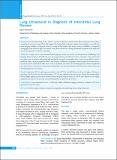Please use this identifier to cite or link to this item:
https://hdl.handle.net/20.500.14356/2300| Title: | Lung Ultrasound in Diagnosis of Interstitial Lung Disease |
| Authors: | Manandhar, Sagun |
| Citation: | ManandharS. (2023). Lung Ultrasound in Diagnosis of Interstitial Lung Disease. Journal of Nepal Health Research Council, 20(4), 916-921. https://doi.org/10.33314/jnhrc.v20i4.4288 |
| Issue Date: | 2022 |
| Publisher: | Government of Nepal; Nepal Health Research Council; Ramshah Path, Kathmandu, Nepal |
| Keywords: | B lines High-resolution computed tomography Interstitial lung disease Lung ultrasound |
| Series/Report no.: | Oct-Dec, 2022;4288 |
| Abstract: | Abstract Background: Interstitial lung disease denotes a group of disorders which mainly affects pulmonary interstitium consisting of connective tissue fibers that support the lungs. High-resolution computed tomography is currently the main imaging modality of diagnosis, however except for few major cities in the country, availability of computed tomography scan facility is sparse in remote areas; thus relevant use of lung ultrasound in patients with suspected interstitial lung disease could be rewarding. Methods: A single center cross-sectional clinical diagnostic study was carried out at department of Radiology and Imaging, Patan Academy of Health Sciences after approval from institutional review committee. Lung ultrasound was done prior to patients undergoing high-resolution computed tomography chest. Senstivity, specificity, positive predictive value , negative predictive value , and accuracy of different echographic criteria–positive chest area score, total B lines score 5 and total B lines score 10 were calculated. Association of non-homogeneity of B lines and pleural line abnormalities with presence of interstitial lung disease, and association between B3 and B7 lines with alveolar and interstitial pattern were derived. Results: Sensitivity (97.4%) and negative predictive value (97.9%) of total B lines score 5 was the highest. Maximum specificity (70.7%), PPV (61.4%) and accuracy (77.2%) was ofpositive chest area score. Pleural line abnormalities showed highly significant association with interstitial lung disease(p=0.003). B3 and B7 lines illustrated very highly significant association with alveolar and interstitial pattern respectively (p<0.001). Conclusions: Lung ultrasound can be a valid and reliable additional imaging method in evaluation of ILD in appropriate clinical scenario. Keywords: B lines; high-resolution computed tomography; interstitial lung disease; lung ultrasound |
| Description: | Original Article |
| URI: | https://hdl.handle.net/20.500.14356/2300 |
| ISSN: | Print ISSN: 1727-5482; Online ISSN: 1999-6217 |
| Appears in Collections: | Vol 20 No 04 Issue 57 Oct-Dec, 2022 |
Files in This Item:
| File | Description | Size | Format | |
|---|---|---|---|---|
| 4288-Manuscript-32171-1-10-20230720.pdf | Fulltext. | 546.07 kB | Adobe PDF |  View/Open |
Items in DSpace are protected by copyright, with all rights reserved, unless otherwise indicated.
